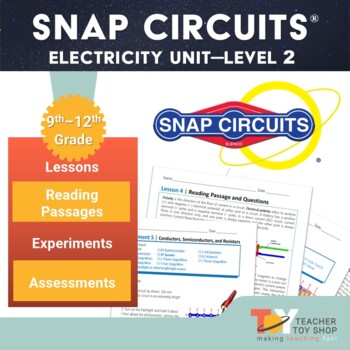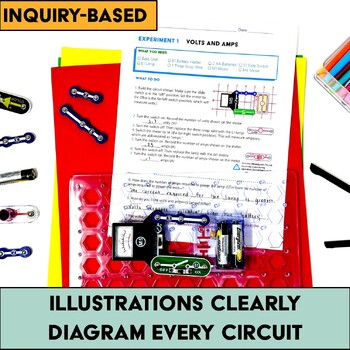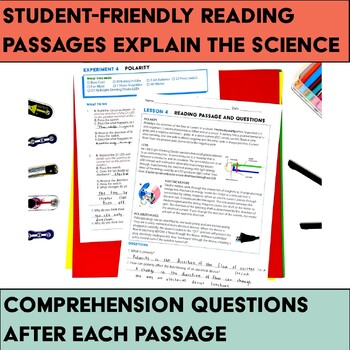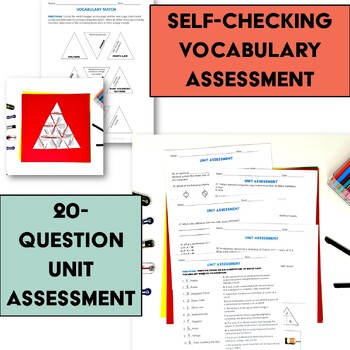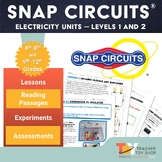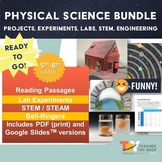Snap Circuits Electricity Unit 2 - Lessons, Experiments, and More!
- PDF
- Easel Activity
Also included in
- Embark on an educational adventure through electricity with this comprehensive resource - Snap Circuits Electricity Bundle - Units 1 and 2. This bundle features a total of sixteen interactive Snap Circuit experiments and lessons, providing complete and engaging electricity units for both school andPrice $20.99Original Price $23.98Save $2.99
- All of Teacher Toy Shop's Physical Science resources in one place! These are some of the many topics included: waves, forces and motion, matter and energy, solar system, electricity and magnetism, sound, heat transfer, STEM, scale models, graphing, electricity, states of matter, density, propertiesPrice $118.61Original Price $148.61Save $30.00
- All of Teacher Toy Shop's Electricity Science resources in one place! Learn about circuits, electricity and magnetism, conservation of energy, STEM, properties of matter, and more. Includes circuit building Winter Holiday projects and Halloween activities. These are engaging and interactive lessonsPrice $36.99Original Price $44.94Save $7.95
Description
Explore the world of electricity with Snap Circuits Electricity Unit 2 - Lessons, Experiments, and More!
Building upon the foundation laid in Snap Circuits Unit 1, this unit offers eight engaging experiments and lessons designed to deepen students' understanding of electricity concepts. Through interactive labs and guided questions, students explore topics such as volts and amps, Ohm's Law, watts, polarity, conductors, and resistors, all presented in student-friendly language and fully illustrated for clarity.
In addition to hands-on experiments, this unit includes a vocabulary activity to reinforce key terms and a comprehensive assessment to evaluate student comprehension. With an emphasis on STEM principles, students not only learn about electricity, but also explore its applications in technology, including binary code and schematic diagrams. The inclusion of topics like Rube Goldberg machines and the Law of Conservation of Energy adds a dynamic and interdisciplinary dimension to the curriculum.
To complete these lessons, a Snap Circuits kit is required, such as the Snap Circuits Junior Kit Model SC-100 or Snap Circuits Classic model SC-300. Additionally, a Snap Circuits 6SCM5 5V-1mA-1A Meter is needed for measuring voltage and amps. With options for both classroom and home use, this product is ideal for traditional, distance, or remote learning environments.
Authorized by Elenco Electronics Inc., the company behind Snap Circuits, this unit ensures quality and authenticity in teaching electricity concepts.
Elevate your physical science curriculum with Snap Circuits Electricity Unit 2 - a comprehensive resource for engaging, hands-on learning experiences in electricity.
► Topics Covered:
- Volts and amps — understanding current and voltage
- Ohm's Law — resistors and the relationship between resistance, current and voltage
- Watts — joules and the relationship between power, current and voltage
- Polarity
- Conductors, semiconductors, and resistors
- Electricity in technology — binary code
- Schematic diagrams
- Rube Goldberg machines and the Law of Conservation of Energy
► Materials Needed: You will need a Snap Circuits kit to complete these lessons. Any of the following kits can be used: Snap Circuits Junior Kit Model SC-100, Snap Circuits Classic model SC-300, Snap Circuits Pro, Snap Circuits Extreme, Snap Circuits Light, Snap Circuits Training Programs SC-300R, 500R and 750R. You will also need a Snap Circuits 6SCM5 5V-1mA-1A Meter for students to measure voltage and amps. You can see an image of the meter in the preview. Information is provided for how to purchase this meter.
⚠️ BUNDLE & SAVE! ⚠️ Get units 1 and 2 of my Snap Circuits Electricity Lessons together and SAVE big! Click here to view the bundle!
You Might Also Like...
- Snap Circuits Lessons and Experiments Level 1
- STEM Electricity Paper Circuit Cards Activity | Circuits Project
- Print and Assemble Life-Size Skeleton
- Printable Hilarious Space Board Game
✪ Don't forget to follow Teacher Toy Shop to be the first to know about new products, sales and freebies!

